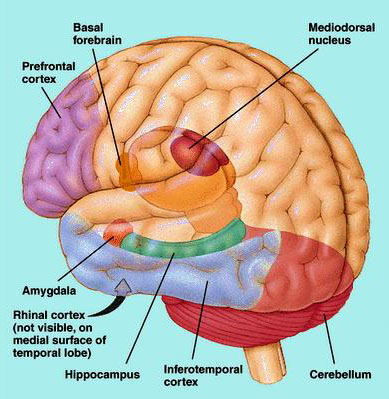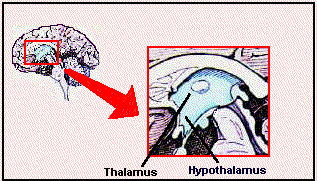The Biology of Music
Music may soothe the troubled
breast. It might even be the food of love. But how does it cast its spell?
Romantics can take comfort from the fact that science does not yet have all the
answers. But it has some.
When philosophers debate what it is that makes humans unique among animals, they
often point to language. Other animals can communicate, of course. But despite
the best efforts of biologists working with beasts as diverse as chimpanzees,
dolphins and parrots, no other species has yet shown the subtleties of syntax
that give human languages their power. There is, however, another sonic
medium that might be thought uniquely human, and that is music. Other species
can sing (indeed, many birds do so better than a lot of people). But birdsong,
and the song of animals such as whales, has a limited repertoire—and no other
animal is known to have developed a musical instrument.
Music is strange stuff. It is clearly different from language. People can, nevertheless, use it to communicate things—especially their emotions. And when allied with speech in a song, it is one of the most powerful means of communication that humans have. But what, biologically speaking, is it? Music’s effect on the outer layers of the brain—the temporal and even the visual cortex—is only half the story, however. These are the places in which the signal is being dissected and processed. The place where it is having its most profound effect is in the brain’s emotional core—the limbic system.
From The Biology of Music - http://cogweb.ucla.edu/Abstracts/Music_00.html
From Mind's Eye to Emotion's Seat
|
HUMPBACK WHALES use many of the same rhythms and patterns as human composers in their songs, tempting some scientists to speculate that a universal music awaits discovery. |
"Music goes much deeper than that—below the outer layers of the auditory and visual cortex to the limbic system, which controls our emotions. The emotions generated there produce a number of well-known physiological responses. Sadness, for instance, automatically causes pulse to slow, blood pressure to rise, a drop in the skin's conductivity and a rise in temperature. Fear increases heart rate; happiness makes you breathe faster. By monitoring such physical reactions, Carol Krumhansl of Cornell University demonstrated that music directly elicits a range of emotions. Music with a quick tempo in a major key, she found, brought about all the physical changes associated with happiness in listeners. In contrast, a slow tempo and minor key led to sadness.
From Music and the Brain: Processing and Responding - http://serendip.brynmawr.edu/bb/neuro/neuro99/web1/Sancar.html
![]()
Emotional Intelligence
![]()
Daniel Goleman wrote "Emotional Intelligence: Why it Can Matter More than IQ." Goleman describes emotional intelligence as "a different way of being smart. It includes knowing what your feelings are and using your feelings to make good decisions in life. It's being able to manage distressing moods well and control impulses. It's being motivated and remaining hopeful and optimistic when you have setbacks in working toward goals. It's empathy; knowing what the people around you are feeling. And it's social skill--getting along well with other people, managing emotions in relationships, being able to persuade or lead others.
He describes the "physiology of the brain and the relationship between the emotional brain and the brain's executive areas....The prefrontal lobes just behind the forehead are where working memory resides. Working memory is what you are paying attention to at any given point. So everything you are mulling over, making a decision about, or are learning, is at first in working memory. All learning is in working memory. And the emotional centers that control moods like anxiety or anger have very strong connections to the prefrontal areas. So if a child is chronically anxious or angry or upset in some way, he experiences that as intruding thoughts. He can't keep his mind off the thing he is worried about." See the limbic system.
Emotional Intelligence Skills (Jensen lists specific research conducted on each of the following skills in his book - Music with the Brain in Mind)
| Identifying and labeling feelings | |
| Expressing feelings appropriately | |
| Understanding and managing feelings | |
| Controlling impulses and gratification | |
| Reducing Stress | |
| Knowing the difference between feelings and actions. | |
| See website resources below. |
Effects of Music on Emotions
| Exposure, may help children identify and manage their emotional states. | |
| Enhances ability in children to detect emotion. | |
| Teaching how to listen to music (for tone, rhythm, pitch, volume, lyrics, etc.) may increase their attention and focus. | |
| May foster self-confidence. | |
| Can be used to regulate mood by altered states. | |
| Enabled students to draw out, relax, unify, and perform in social interactions. | |
| Improved engagement and socialization | |
| Music has mood-enhancing effects. | |
| The emotive-aesthetic experience is important as listening and appreciation skills improve. |
| Brainwave | Cycles Per Second (CPS) | Brainwave Activity |
 |
1-4 cps | deep sleep state |
| 4-7 cps | twilight zone - half awake and half asleep | |
| 8-12 cps | relaxed alertness, reflection, calm, prepared | |
| 12-25 cps | busy classroom activities, discussion | |
| Super Beta (no example) | 25+ cps | intensity,
drama, exercise, simulations
|
 Music and Relaxation (from
Jensen)
Music and Relaxation (from
Jensen)
| There's a strong connection between the mind and the body. | |||||||||||
| Music modulates our body's stress responses. | |||||||||||
| Music can decrease or increase stress levels. | |||||||||||
| Music is a strong and powerful mood enhancer. | |||||||||||
| Music strengthens our immune systems and enhances wellness. | |||||||||||
| Sounds connect us to our sympathetic and parasympathetic (stress/distress response) nervous systems. | |||||||||||
| Music impacts blood flow in the body. | |||||||||||
Evidence exists that music can
be helpful in healing.
|
Websites
| The Autonomic Nervous System - Kid's Neuroscience Website - http://faculty.washington.edu/chudler/auto.html | |
| Music Reduces Stress in Surgery Patients - Kid's Neuroscience Website - http://faculty.washington.edu/chudler/surgm.html | |
| My Body - Kid's Health - http://kidshealth.org/kid/body/mybody.html | |
| American Music Therapy Association - http://www.musictherapy.org/ | |
| Music Therapy - http://www.holistic-online.com/stress/stress_music-therapy.htm |
![]()
A controversial study of University of California Irvine students was conducted to determine if students who listened to Mozart's Sonata K. 448 for ten minutes prior to testing had higher test scores than those of a control group.
Some results of the "Mozart Effect"
| Evidence has been reported in 26 of 27 studies that were done to duplicate the effect. | |
| Effect is cross-species (occurs in rats brains as well), | |
| Music impacts neural firing patterns in epileptics as demonstrated in PET scans (improved spatial reasoning) | |
| Effect present in preschoolers and not dependant on musical talent | |
| EEG Studies demonstrated enhanced synchronization of neuronal firing activity of the right frontal and left temporal-parietal areas compared to students listening to a story. |
![]()
 Music Activities in the Classroom that Impact Emotions
Music Activities in the Classroom that Impact Emotions
(From Jensen - Music with the Brain in Mind)
| Alpha
brainwaves are commonly recorded when one is quiet and relaxed.
Music can induce this state and activate a kind of creative
daydreaming. Usually the eyes are closed Alpha waives are
formed in the frequency of 8-12 cycles per second. This state is
induced with a slower beat.
|
|
| Beta
brainwaves are the most common type of brain activity recorded in normal
conscious states. These brainwaves undulate from 18-40
cycles per second. Beta means "active." You can
induce this state with very upbeat music, such as pop, rock, or up tempo
instrumentals. Some classical, jazz, and dance selections qualify
as well.
|
|
| Theta brainwaves are often recorded in states of high creativity. These waves are formed at 4-7 cycles per second. This state is the twiglight zone between sleep and wakefulness. This music maintains a very ethereal slow beat. |
Music for Arousal
Effect
| |||||||||||||||
Background Music
| |||||||||||||||
Openings
| |||||||||||||||
Unity
| |||||||||||||||
Focused Concentration
| |||||||||||||||
Transitions
| |||||||||||||||
Punctuate an Activity
| |||||||||||||||
State Management
| |||||||||||||||
Music as a Primer
|
Helping Students Understand Musical Impact
| Noticing Sensations - Invite them to notice comforting sensations in their body - pleasant heaviness, warmth, calm, steadiness, etc. | |
| Progressive Relaxation - Ask student to visualize thier feet, ankles, calves, knees, and so on, successively relaxing each area of the body. | |
| Tension Release - Have learners tense and hold rigid successive body parts for a few seconds at a time - then let go of the tension seeing the tension leave their body. | |
| Physical Relaxation - Help them induce a state of relaxation that increases receptivity. | |
| Semi-guided Imagery - Ask learners to close their eyes as you describe a peaceful setting. Invite the learners to let their imagination finish the story. | |
| Unguided Imagery - Encourage your students to allow their imaginations to take flight stimulated by the images and emotional nuances in the music. | |
| Image Streaming - Have student describe images, thought, impressions, feelings, associations, etc. in a journal or to a partner or into a tape recorder. |
 Music
to Use in the Classroom
Music
to Use in the Classroom
Classical Music MIDI and Audio Files
Classical Music Audio Files
| |||||
| Classical Music MIDI Archives - http://www.classicalarchives.com | |||||
| MIDI music files of all composers - http://www.classical.net/music/links/midiarch.html | |||||
| Classical Music MIDI files - http://www.midiworld.com/classic.htm |
Songs for Teaching Audio Files - http://www.songsforteaching.com/
| Using Music in Classroom Management | |||||||||||
See our
music for classroom
| |||||||||||
| Action Songs that Call for Physical Movement - Research indicates that children learn best when they can be physically active! | |||||||||||
Social and
Emotional Learning
|
Sounds of Nature
| Nature Songs - http://www.naturesongs.com/ | |
| Relaxing Sounds of Nature - http://sulger.net/soundsculptures/ | |
| Nature Sound Studio - http://www.naturesound.com/corepage/core.html |
New Age Music Instrumentals
| Piano Meditations - http://www2.pro-ns.net/~thoryara/audio.htm | |
| Dave"s Cave - UK - Free Electronic, Ambient, Dance Music - http://www.davehall.force9.co.uk/music/music.htm |
![]()
 Enhancing the Classroom Emotional Atmosphere
with Music - Orchestrating your Classroom Environment
Enhancing the Classroom Emotional Atmosphere
with Music - Orchestrating your Classroom Environment
Try some music you've never used before!
In what ways could you use instrumental music to alter the mood in your classroom? What types of instrumental music would you use to energize the students? List specific titles, composers, or CDs. What particular learning activities might be most effective with a musical component? Try out some of the free online music tracks listed above, or try a several selections from your own instrumental CD collection. Describe the purpose and student response. What instrumental music have you found useful for motivating students to stay on task. What music helps them mellow out? What background music have you tried with your students and explain its effectiveness in providing a soothing, unobtrusive environment? What music have you tried that seems to distract or agitate students? What music do you find relaxes students? If you were to prepare students for an exam by playing 10 minutes of music (like the "Mozart Effect" experiment), what piece of music would you choose?
How do you provide musical transitions between tasks and activities? What music do you like to use to punctuate events and activities in your room? Name any other effective musical selections you've found useful for creating a joyous, creative, and up-beat classroom. What songs do you like to sing with your students on a regular basis? Share music or songs that you have found useful for promoting a caring positive environment? What songs do you use to foster respect for diversity in your classroom? What songs do you use with dance, movement, or gross/fine motor activity? How do you orchestrate your classroom environment?
![]()
Major Components of the Limbic System - Emotional Center



Amygdala
A little almond shaped structure, deep inside the antero-inferior region of the temporal lobe, connects with the hippocampus, the septal nuclei, the prefrontal area and the medial dorsal nucleus of the thalamus. These connections make it possible for the amigdala to play its important role on the mediation and control of major affective activities like friendship, love and affection, on the expression of mood and, mainly, on fear, rage and aggression The amygdala, being the center for identification of danger, is fundamental for self preservation. When triggered, it gives rise to fear and anxiety which lead the animal into a stage of alertness, getting ready to flight or fight.
HippocampusIs particularly involved with memory phenomena, specially with the formation of long-term memory (the one that, sometimes, lasts forever).

Thalamus
Lesion or stimulation of the medial dorsal and anterior nuclei of the thalamus are associated with changes in emotional reactivity. However, the importance of these nuclei on the regulation of emotional behavior, is not due to the thalamus itself, but to the connections of these nuclei with other limbic system structures. The medial dorsal nucleus makes connections with cortical zones of the pre-frontal area and with the hypothalamus.
HypothalamusThe hypothalamus is also believed to play a role in emotion. Specifically, its lateral parts seem to be involved with pleasure and rage, while the median part is like to be involved with aversion, displeasure and a tendency to uncontrollable and loud laughing. However, in general terms, the hypothalamus has more to do with the expression (symptomatic manifestations) of emotions than with the genesis of the affective states. When the physical symptoms of emotion appear, the threat they pose returns, via hypothalamus, to the limbic centers and, thence, to the pre-frontal nuclei, increasing anxiety. This negative feed-back mechanism can be so strong as to generate a situation of panic.
Brain Stem
The brainstem is the region responsible for the "emotional reactions", (indeed, they are just reflex answers) of inferior vertebrates, like reptiles and amphibians. Even in humans, these primitive structures remain active, not only as alerting mechanisms, vital for survival, but in the maintenance of the sleep-awake cycle.
![]()
 Emotional
Intelligence Websites
Emotional
Intelligence Websites
The Brain and Emotions
Mozart Effect Websites - Pro and Con
| The Musical Brain from Kid's Neuroscience Website - http://faculty.washington.edu/chudler/music.html | |
| Anxiety and Memory; Their Effects on Cognition and Musical Performance - from Kids Neuroscience Site - http://faculty.washington.edu/chudler/dl3.html | |
| What is the Mozart Effect? Don Campbell - http://www.mozarteffect.com/learn/read.html | |
| The Mozart Effect Website - http://www.mozarteffect.com/ | |
| Articles on the Mozart Effect - http://www.mindinst.org/MIND3/indexresearchers.html | |
| More on Mozart Effect - http://parenting-baby.com/Parenting-Baby-Music-Research/Music-Research.html | |
| Gordon Shaw and the Mind Institute - http://www.mindinst.org/MIND2/research.html | |
| More from the Mind Institute - http://www.mindinstitute.net/MIND3/mozart/mozart.php | |
| The Mozart Effect - Shaw - http://skepdic.com/mozart.html | |
| Mozart Effect - BBC - http://www.bbc.co.uk/radio4/science/mozarteffect.shtml | |
| EdWeek - http://www.edweek.org/ew/vol-17/30music2.h17 | |
| Mozart Heals - http://www.mozart-heals.com/ |

Copyright 2003 by Carla Piper, Ed. D.